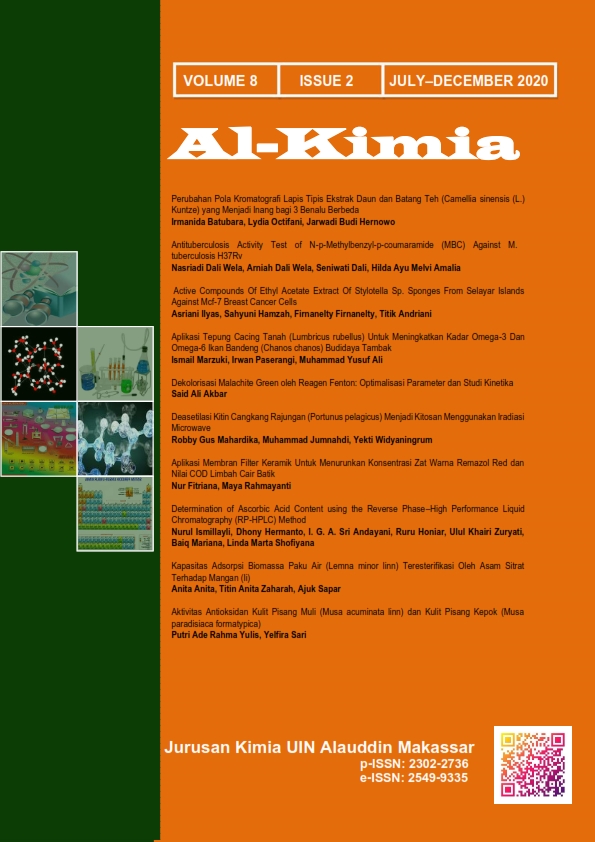Perubahan Pola Kromatografi Lapis Tipis Ekstrak Daun dan Batang Teh (Camellia sinensis (L.) Kuntze) yang Menjadi Inang bagi 3 Benalu Berbeda
Abstract
Plants produce primary and secondary metabolite compounds depending on their growth conditions. The tea plant (Camellia sinensis (L.) Kuntze that hosts Loranthus produces different metabolites compared to those not hosting. This study aims to determine the change in the thin layer chromatography pattern (TLC) of leaf and stem tea extract that is the host 3 types of Loranthus tea namely Loranthus atropurpureus, Loranthus cochinchinensis, and Loranthus pentandrus. Leaf and stem tea extracts that host 3 types of Loranthus were separated using TLC with stationary phase of silica gel 60 F254 and the mobile phase of DCM: MeOH: n-hex (48:1:1). Separation results was detected using UV lamps 254 and 366 nm. The changes of the band's area of each extract were determined using software ImageJ. The results showed a change in TLC patterns. The declining band's area was found in bands detected at 366 nm for the host's stem and tea leaves. The increasing band's areawere found on bands detected at 254 nm especially on tea leaves that host. In conclusion, the change in TLC pattern can be used to determine the compounds that change due to tea plants to host and can be alternative utilization.Downloads
References
[AOAC] Association of Official Analytical Chemist. 2006. Official methods of AOAC International. Edisi ke-14. Arlington: AOAC.
Arifin H, Anggraini N, Handayani D, Rasyid R. 2006. Standarisasi Ekstrak Etanol Daun Eugenia cumini Merr., Jurnal Sains dan Teknologi Farmasi, 11(2), 88-93.
Athiroh N, Permatasari N, Sargowo D, Widodo MA. 2014. Effect of Scurrula atropurpurea on Nitric Oxide, Endothelial Damage, and Endothelial Progenitor Cells of DOCA-salt Hypertensive Rats, Iranian Journal of Basic Medical Sciences, 17(8), 622-625.
Azizah B, Salamah N. 2013. Standarisasi Parameter Non Spesifik dan Perbandingan Kadar Kurkumin Ekstrak Etanol dan Ekstrak Terpurifikasi Rimpang Kunyit, Jurnal Ilmiah Kefarmasian, 3(1), 21-30.
Borges CN, Bruns RE, Almeida AA, Scarminio IS. 2007. Mixture-mixture Design for The Fingerprint Optimization of Chromatographic Mobile Phases and Extraction Solutions for Camellia sinensis, Analytica Chimica Acta, 595 (2007), 28-37.
[BPS RI] Badan Pusat Statistik Republik Indonesia. 2019. Statistik teh Indonesia 2018. Jakarta: BPS RI.
Figueiredo AC, Barroso JG, Pedro LG, Scheffer JJC. 2008. Factors Affecting Secondary Metabolite Production in Plants: Volatile Components and Essential Oils, Flavour and Fragrance Journal, 23, 213-226.
Harborne JB. 1987. Metode fitokimia penuntun cara modern menganalisa tumbuhan. Edisi ke-2. Padmawinata K, Soediro I, penerjemah. Bandung: Institut Teknologi Bandung. Terjemahan dari: Phytochemical methods.
MacKinnon J, Phillipps K, van Balen B. 1998. Seri panduan lapangan burung-burung di Sumatera, Jawa, Bali, dan Kalimantan.
Rahardjaningtrah W, Adikerana A, Martodiharjo P, Supardiyono EK, van Balen B, penerjemah; Sumandipura S, Kartikasari A, editor. Bogor: Puslitbang Biologi-LIPI. Terjemahan dari: Fieldguide to the birds of Borneo, Sumatera, Java, and Bali.
Markham KR. 1988. Cara mengidentifikasi flavonoid. Padmawinata K, penerjemah. Bandung: Penerbit ITB. Terjemahan dari: Techniques of flavonoid identification.
Ohashi K, Winarno H, Mukai M, Inoue M, Prana MS, Simanjuntak P, Shibuya H. 2003. Cancer Cell Invasion Inhibitory Effects of Chemical Constituents in the Parasitic Plant Scurrula atropurpurea (Loranthaceae), Chemical and Pharmaceutical Bulletin, 51(3), 343-345.
Pitojo S. 1996. Benalu hortikultura pengendalian dan pemanfaatan. Indonesia: Trubus Agriwidya.
Qiu H, Gilbert MG. 2003. Loranthaceae, Flora of China, 5, 220.
Reich E, Schibli A. 2006. High-performance thin-layer chromatography for the analysis of medicinal plants. New York: Thieme Medical Publishers, Inc.
Samsi M. 2007. Ekstrak Benalu Teh (Scurrula oortiana) sebagai Imunomodulator dan Antitumor Infeksi Marek’s Disease Virus (MDV) Serotipa 1 Onkogenik pada Ayam, Disertasi, Bogor. Institut Pertanian Bogor.
Tambunan RM, Bustanussalam, Simanjuntak P, Murwani R. 2003. Isolasi dan Identifikasi Kafein dalam Ekstrak Air Daun Benalu Teh, Scurrula junghunii, Loranthaceae, Jurnal Ilmu Kefarmasian Indonesia, 1(2), 16-18.
Uji T, Sunaryo, Rachman E. 2007. Keanekaragaman Jenis Benalu Parasit pada Tanaman Koleksi di Kebun Raya Eka Karya Bali, Jurnal Berkala Penelitian Hayati, 13, 1-5.
Van Leeuwen WMD. 1955. On the Biology of Some Javanese Loranthaceae and the Role Birds Play in Their Life-Histories, The Auk, 72(3), 305-306.
Authors who publish with this journal agree to the following terms:
1) Authors retain copyright and grant the journal right of first publication with the work simultaneously licensed under a Creative Commons Attribution License that allows others to share the work with an acknowledgement of the work's authorship and initial publication in this journal.
2) Authors are able to enter into separate, additional contractual arrangements for the non-exclusive distribution of the journal's published version of the work (e.g., post it to an institutional repository or publish it in a book), with an acknowledgement of its initial publication in this journal.
3)Authors are permitted and encouraged to post their work online (e.g., in institutional repositories or on their website) prior to and during the submission process, as it can lead to productive exchanges, as well as earlier and greater citation of published work (See The Effect of Open Access).


